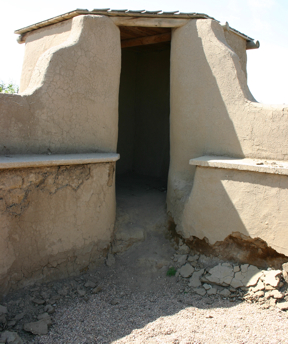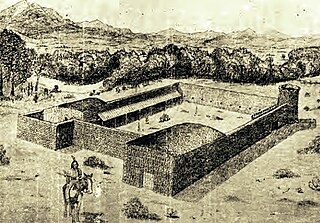
John David Albert was an American mountain man.

Charles Bent was an American businessman and politician who served as the first civilian United States governor of the New Mexico Territory, newly invaded and occupied by the United States during the Mexican-American War by the Military Governor, Stephen Watts Kearny, in September 1846.

Fort Vasquez is a former fur trading post 35 miles (56 km) northeast of Denver, Colorado, United States, founded by Louis Vasquez and Andrew Sublette in 1835. Restored by the Works Progress Administration in the 1930s, it now lies in a rather incongruous position as U.S. Route 85 splits to run either side of the building. History Colorado took possession of the property in 1958 and runs it as a museum to display exhibits of the fur-trade era.

Fort Saint Vrain was an 1837 fur trading post built by the Bent, St. Vrain Company, and located at the confluence of Saint Vrain Creek and the South Platte River, about 20 miles (32 km) east of the Rocky Mountains in the unorganized territory of the United States, in present-day Weld County, Colorado. A historical marker notes the place where Old Fort St. Vrain once stood, today at the end of Weld County Road 40, located about seven miles north of Fort Vasquez, Colorado. Among those who helped to establish the fort was Ceran St. Vrain, after whom it was named.

The Trapper's Trail or Trappers' Trail is a north-south path along the eastern base of the Rocky Mountains that links the Great Platte River Road at Fort Laramie and the Santa Fe Trail at Bent's Old Fort. Along this path there were a number of trading posts, also called trading forts.

The Taos Mountain Trail was the historic pathway for trade and business exchanges between agrarian Taos and the Great Plains (Colorado) from pre-history through the Spanish Colonial period and into the time of the European and American presence. The Taos Mountain Trail, between northern New Mexico and southern Colorado, connected the high mountain traders and their trading partners north and south of the Sangre de Cristo Mountains. Also called the Trapper's Trail, the pathway was only wide enough for people on foot or horses in single file, but it shortened a trip from Taos to the plains farther north from nearly two weeks to three days in good weather. The Taos Mountain Trail was also known as the Sangre de Cristo Trail and the Aztec Trail.

The early history of the Arkansas Valley in Colorado began in the 1600s and to the early 1800s when explorers, hunters, trappers, and traders of European descent came to the region. Prior to that, Colorado was home to prehistoric people, including Paleo-Indians, Ancestral Puebloans, and Late prehistoric Native Americans.
The Fort Pueblo massacre was an attack that occurred on December 25, 1854, against Fort Pueblo, Colorado, also known as El Pueblo, a settlement on the north side of the Arkansas River, 1⁄2 mile west of the mouth of Fountain Creek, above the mouth of the Huerfano. The attack followed the deaths of Chief Chico Velasquez and others who died of smallpox after having been given blanket coats which the Muache believed had been deliberately contaminated. Coalition forces of over 100 Muache Utes and Jicarilla Dindes under the leadership of Chief Tierra Blanco led the attack against Fort Pueblo, killing 15 men, and capturing one woman, and two boys. Later on, the Muache killed the woman south of Pueblo at the Salt Creek. 2 women and 1 man survived the joint military operation, and the two boys who were captured, eventually returned.

Maria Teresa "Teresita" Sandoval Suazo (1811–1894) was among the first women of European heritage to live in the Arkansas Valley of present-day Colorado. She is one of the founders of El Pueblo in the current city of Pueblo, Colorado. She managed a ranch, the Doyle Settlement, in her later years.

Fort Lupton, located in the city of the same name, was a trading post from 1836 or 1837 to 1844. After operating as a stage coach station and used as a house, the building fell into disrepair and crumbled to all but a portion of one wall by the early 20th century. The trading post has been reconstructed yards away from its original site and is now part of the South Platte Historical Park in northwestern Fort Lupton, Colorado.
El Pueblo, also called Fort Pueblo, was a trading post and fort near the present-day city of Pueblo in Pueblo County, Colorado. It operated from 1842 until 1854, selling goods, livestock, and produce. It was attacked in 1854, killing up to 19 men and capturing three people. A recreation of the fort is located at the El Pueblo History Museum at the site of the original fort.

Fort Sedgwick, also known as Post at Julesburg, Camp Rankin, and Fort Rankin was a U.S. military post from 1864 to 1871, in Sedgwick County, Colorado. There are two historical markers for the former post. The town was named for Fort Sedgwick, which was named after John Sedgwick, who was a major general in the Union Army during the American Civil War.
Fort Davy Crockett, also called Fort Misery, was a trading post of the late 1830s and early 1840s. The site is located within Browns Park National Wildlife Refuge in Moffat County, Colorado. Unlike most trading posts within the confines of the current state of Colorado, Fort Davy Crockett was located west of the Rocky Mountains in what is now northwestern Colorado.

Fort Wicked was a ranch and stage station on the Overland Trail from 1864 to 1868 in present-day Merino, Colorado. A historical marker commemorating the ranch is located at US 6 and CR-2.5. The ranch itself was located near a ford of the South Platte River, near where US-6 now crosses over the river. Fort Wicked was one of the few places along the trail to Denver that withstood an attack by Lakota, Cheyenne, and Arapaho Native Americans in the Colorado War of 1864. It was named Fort Wicked for the "bitter defence" made by Holon Godfrey, his family, and his employees.
Milk Fort, also known as Fort Leche, Pueblo de Leche, Fort El Puebla, Peebles Fort, and Fort Independence was a trading post and settlement in Otero County, Colorado in the late 1830s. There are no remains of the settlement.
Hardscrabble was a settlement established by traders and trappers in the 1840s near the fork of Adobe and Hardscrabble Creeks in present-day Fremont County, Colorado. It was called San Buenaventura de los Tres Arrollos—for three creeks Newlin, Adobe, and Hardscrabble—by its founders, George Simpson, Joseph Doyle, and Alexander Barclay. The name Hardscrabble became more common.
Alexander Barclay was an American frontiersman. After working in St. Louis as a bookkeeper and clerk, he worked at Bent's Old Fort. He then ventured westward where he was a trapper, hunter, and trader. Barclay entered into a common-law relationship with Teresita Sandoval, one of the founders of the settlement and trading post El Pueblo. He helped settle Hardscrabble, Colorado and built Fort Barclay in New Mexico.

The Greenhorn Valley lies in southern Pueblo County, Colorado just east of Greenhorn Mountain. It includes the communities of Colorado City and Rye.
John Brown (1817-1889) was a mountain man and trader in the Arkansas River valley in Colorado in the 1840s. From the 1850s until his death he was a prominent businessman and citizen of San Bernardino, California.












